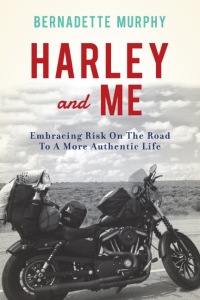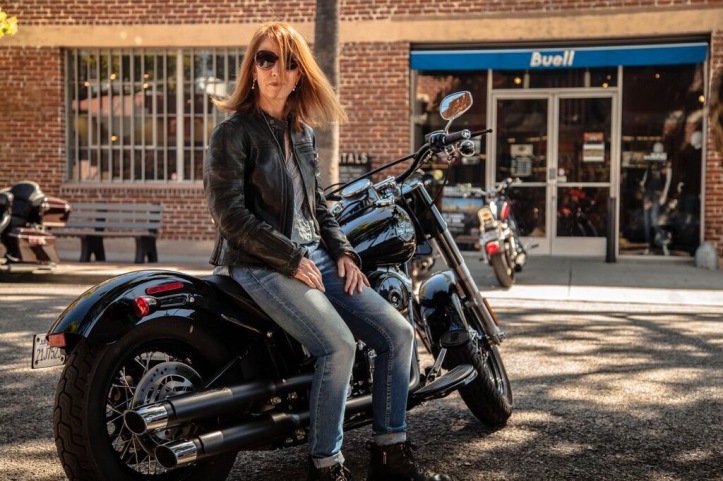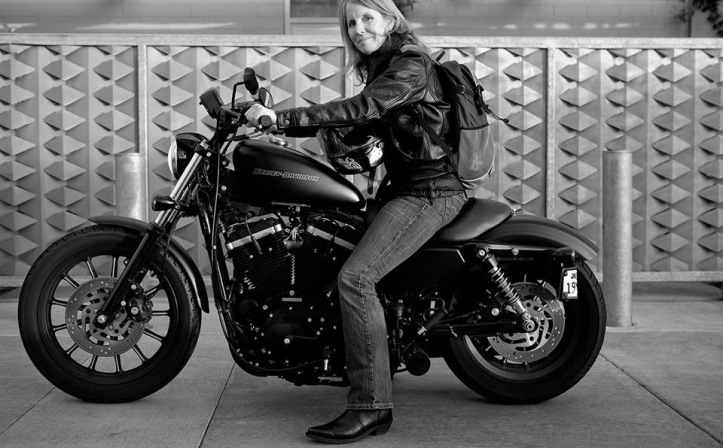I want to thank Bernadette Murphy for answering my questions! Her bio and contact links are at the bottom of the page.

Grab the Lapels: What is your writing process like?
Bernadette Murphy: I adore writing something new when it’s fresh and I have some idea of what I’m doing. That experience, unfortunately, doesn’t happen all that often. With new material, I’m often casting about, trying to figure out what I’m writing, what I’m trying to say. I hate that not-knowing stage, but I also know it’s necessary and doesn’t last forever – usually.
Revising, on the other hand, is more painless and I find it super creative. I love shaping a narrative, cutting it up into little bits and then reconstituting the whole once I’ve figured out what the main thing is I’m shooting for. I’ll often write a longish first draft, one that meanders and doesn’t quite know what it’s trying to be. But the revision stage, once I’ve done some thinking and non-thinking about “what is this about?” can be fun and magical. I love seeing how the shape starts to reveal itself, how, as I cut and hone and cut some more, the core idea begins to shimmer a bit and stand out from the background. So while I thrive on the energy that comes with starting something new and its freshness, I think I favor revising.
One of my early mentors, Leonard Chang (a novelist and now a writer for television) once told me this analogy: Other artists start out with some kind of media: paints and a canvas, a camera and an image, a piece of wood to be carved. Writers start out with nothing beyond the alphabet, little glyphs on a page. In writing the first draft, we create our medium. By the time we’re done with the first draft, about all we have is a big, wet pile of clay. The revision stage is where we really practice our art. That’s when make that clay into what we envision it as.
GTL: Do you recall how your interest in writing originated?
BM: I always wrote as a kid to make sense of life and to have someone to talk to. I grew up in a household of seven people with one bathroom. The only way to get privacy was to lock myself into the bathroom, climb in the tub and while soaking, fill pages of my Hang-Ten notebook. I never dreamed that I could pursue a career as a writer. It was just something I did.
In community college, I was double majoring in dance and marine biology (like those two go together!), obviously unsure what I was doing about a potential career. I was failing Chemistry and totally lost when the English teacher said, “Have you ever thought about being a writer?”
And the answer was “no.” I had never thought about it. It was like thinking I could be an astronaut or President of the United States. But once he planted that seed, my eyes started to open. At first, I studied journalism and started my career writing things other people wanted me to: journalism, public relations copy, ad copy. But in my 30s, I could finally identify the stories I wanted to tell, stories of the human condition and our struggles with it. I was finally ready to do so.

GTL: Did you learn anything from writing Harley and Me?
BM: Oh my! Yes! I learned that a woman’s hormones basically trick her into being a master nurturer during the childbearing years but that, as we age, we become more like we were when we were younger, around age 11. I was much more gutsy and fearless when I was a kid, but while raising children, I became meek and skittish. It was a relief to realize that my ‘coming out’ as a risk taker was totally normal.
I also learned that I’m tougher and more resilient than I thought I was. Over the course of writing that book, I rode my motorcycle across the country and back, pursued a divorce after a 25-year marriage, lived on my own for the first time in my life, dated for the first time in a quarter of a century, moved to Mo’orea in French Polynesia for a while, and learned to ice climb, among other crazy things. I was shocked and amazed at what I did. Neighbors, my kids, and friends: everyone was shocked. But in a good way. I found out I’m braver than I would have guessed.
And that’s part of why I wrote this book. I think this can be the story for many people, but that unless they try something that feels risky to them – taking a drawing class, starting a business, training to run a 10K – they may never know. My wish is that Harley and Me will encourage people to try something new and discover that untapped reservoir of courage that’s waiting inside them.

GTL: What did you want to be when you grew up, and does this choice influence your writing today?
BM: I was totally lost about what I wanted to be when I grew up, other than a dancing marine biologist! At one point, I thought I wanted to be a nurse, but that was because of cultural programming. Neither of my parents had attended college; they were emigrants from Ireland. I thought the only real choices were teacher or nurse.
The marine biology background shows up in Harley and Me in the chapter “Evolve or Die,” in which I wrote about the researchers on Mo’orea studying coral reef ecology and what they taught me about my need to “re-wild” myself. Also, I’ve been writing a couple of nature/biology pieces recently for Palm Springs Life Magazine lately that uses my biology background. My dance background led to my interest in all things fitness related, and shows up in Harley and Me when I run a half marathon in French Polynesia.
It’s interesting, though. Until you asked this question, I had no idea that those interests were in this book. Thank you for that.
GTL: You’re welcome! Does your writing include any research?
BM: All my books involve research, but this one, by far, included the most. I tapped into neuroscience, endocrinology, psychology, the study of happiness – everything I could find that would lend scientific backing to what I was exploring. I even had my blood taken before and after riding a motorcycle to see how my levels of testosterone, cortisol, and oxytocin changed as the result of riding. The basic question the book asks is twofold: 1) What in the world happened to me, that I suddenly wanted to do risky things when my kids were flying the coop? and, 2) Were these risky things good for me or harmful? I needed science and lots of experts to help me answer these questions in a legit way.
All the books I’ve written have included research because I like to use my experience not so much as the focal point of the story but as the lens to look at a larger question. For example, in Zen and the Art of Knitting, I looked into the creative, spiritual, and meditative qualities of knitting to help me understand my own response to it. I turn to science to help me comprehend what my story alone doesn’t fully reveal and to make my experience more universal.

GTL: Finally, why do you think Harley and Me might be a good pick for a book club?
BM: We all have stories of wanting to do things that scare us and what we have to do to get ourselves over that hump – whether we’re talking skydiving, starting to date again after the end of a long-term relationship, or embracing our own creativity that may have gone dormant.
What’s fun about Harley and Me in a book club setting is that, while I found out I was stronger than I thought I was by learning to ride a motorcycle, other people have similar stories in totally different ways. We share these stories and by the end of the book club meeting, everyone has come up with a list of new things they want to try, coupled with a sense of community support as they make plans to do so. Plus, they now have the scientific backing that helps them see how and why risk makes us healthier neurologically, and the ways it enhances our neuroplasticity. (We also have fun saying big words like that, as if we know what we’re talking about.)
GTL: Thanks so much for visiting Grab the Lapels to share with readers who you are! Read my review of Murphy’s newest book, Harley and Me, HERE.
 Bernadette Murphy served for six years as a weekly book critic for the Los Angeles Times, and has published three books of creative nonfiction: The Tao Gals’ Guide to Real Estate (with Michelle Huneven); The Knitter’s Gift; and the bestselling Zen and the Art of Knitting. Other essays and short stories have been in featured in anthologies, including: Knitting Yarns: Writers on Knitting, edited by Ann Hood; Wild with Child: Adventures of Families in the Great Outdoors, edited by Jennifer Bove and Mark Jenkins; My Little Red Book, edited by Rachel Kauder Nalebuff; Our Working Lives: Short Stories of People and Work, edited by Larry Smith and Bonnie Jo Campbell, and others. She currently serves as core faculty in creative nonfiction MFA program at Antioch University Lost Angeles.
Bernadette Murphy served for six years as a weekly book critic for the Los Angeles Times, and has published three books of creative nonfiction: The Tao Gals’ Guide to Real Estate (with Michelle Huneven); The Knitter’s Gift; and the bestselling Zen and the Art of Knitting. Other essays and short stories have been in featured in anthologies, including: Knitting Yarns: Writers on Knitting, edited by Ann Hood; Wild with Child: Adventures of Families in the Great Outdoors, edited by Jennifer Bove and Mark Jenkins; My Little Red Book, edited by Rachel Kauder Nalebuff; Our Working Lives: Short Stories of People and Work, edited by Larry Smith and Bonnie Jo Campbell, and others. She currently serves as core faculty in creative nonfiction MFA program at Antioch University Lost Angeles.

Now I know why I’ll never be a writer – I hate revising. All those new things I write in the first draft, I really, really want to keep them. But what she says about trying new things in the second half of her life, that rings true for me too.
LikeLiked by 2 people
I get so anxious about writing new stuff. I love revising because I often forget about it in a computer file, so when I go back and read it, I’m typically laughing my ass off (yes, that sounds egotistical, but I’m pretty funny to me).
LikeLiked by 1 person
She sounds like a lot of fun!
“…as we age, we become more like we were when we were younger” – something to look forward to!
LikeLiked by 1 person
Definitely. I was a “never say no” bit of a lunatic as a younger person.
LikeLiked by 1 person
Great interview – sounds like an interesting book too, though I must admit I’m more attracted to Zen and the Art of Knitting, since I used to do a lot of knitting, pre-cat. And since I am so sensitive to anything woollen, I was never knitting to wear but simply for the sense of peace and calm it used to bring me. I now cross-stitch for the same reason… much more cat-friendly. I’m sure that probably enhances my neuroplasticity too! 😉
LikeLiked by 1 person
Why does the cat not like or mesh with knitting? My can LOVES all things knitted; she even has her own little knitted kitty-sized blankey. I believe Bernadette Murphy has a few knitting books! They sound cool!
LikeLike
Because the cats think knitting is a form of cat entertainment! Peace flies out the window when you’re constantly having to retrieve the ball of wool, disentangle it and dry off the cat drool… 😉
LikeLiked by 1 person
[…] copy in exchange for an honest review. To learn more about Murphy’s writing, please check out her Meet the Writer […]
LikeLike
I love that analogy about writing Murphy offers from Leonard Chang! Also love the idea of riding a motorcycle across the States. Ultimate road trip.
LikeLiked by 1 person
I know there are a lot of sought-after trips through Canada, too, but I thought I’d read somewhere (I think in one of my dad’s motorcycle magazines) that there is a famous motorcycle route in Australia.
LikeLiked by 1 person
Yeah, we have a few, I think. Doing the Great Ocean Road that way would be pretty spectacular.
LikeLiked by 1 person
Very interesting interview. I wonder if this is why I’m finally planning to run my marathon in my mid-40s.
LikeLiked by 1 person
Probably! Okay, now you definitely have to read Harley and Me! 🙂
LikeLiked by 1 person
Excellent article.
LikeLiked by 1 person
Thanks! Does it make you want to get a bike? 😃
LikeLiked by 1 person
Yes in a way. But I’m not that young anymore! smiles
LikeLiked by 1 person
Neither was Murphy! Her children are grown!
LikeLiked by 1 person
I know, maybe I will….someday. Smiles.
LikeLiked by 1 person